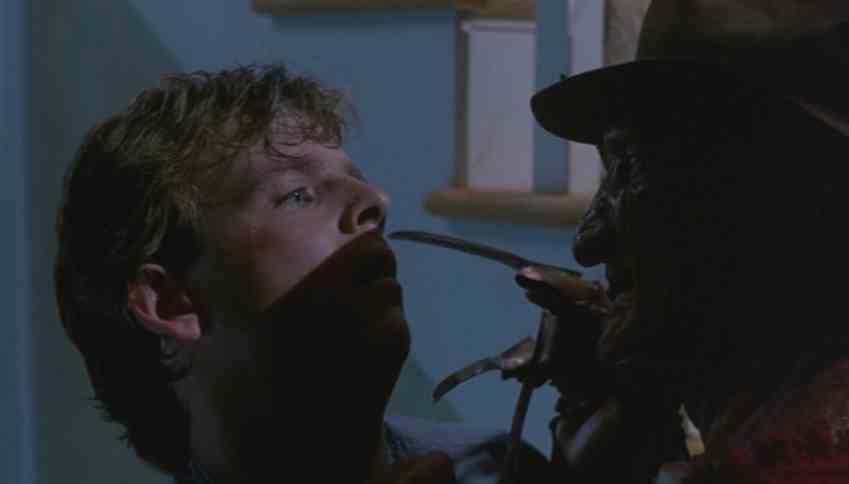Culture
The Bloody Truth: “A Nightmare On Elm Street Part 2: Freddy’s Revenge”

Every week in The Bloody Truth, Calhoun Kersten looks at the deeper subtexts beneath modern horror cinema.
It’s hard to come up with a gayer movie than A Nightmare on Elm Street Part 2: Freddy’s Revenge. Seriously, better men than me have tried and failed. It’s just–it’s just so damn gay. I mean, we’re talking “Liberace in a feather boa singing Liza Minelli with a dick in each hand.” That’s how gay it is. Sure, the fact that its lead actor Mark Patton publicly came out only added to that “hindsight is 20/20” battle, but even before all that, A Nightmare on Elm Street Part 2: Freddy’s Revenge was incredibly gay. But here’s the thing: it should have been. I’m not even coming from the standpoint of “there aren’t enough queer voices in horror” (although homosexuality and horror do have a more complex relationship than the one I have with my father), but because of the purpose of horror.
The point of scary movies is to–well, scare, right? What could possibly be more terrifying than struggling with your own sexuality? It’s actually a pretty scary idea. I mean, particularly at the time in Jesse’s (Patton) life, both a new kid in town and starting out in high school, the idea of being marked as gay could be pretty scary for someone like him. It is only when he forces himself into the heterosexual lifestyle, by kissing Lisa (Kim Myers), that he is freed of his personal demons. This could be argued as a very dated reading, but the fact is that all the supposed tension of this film is built around its male protagonist and his relationships with other men. Of course, there’s the remarkably homoerotic relationship with his perpetually shirtless best friend, bad boy Ron (Robert Rusler). The sado-masochistic relationship between Jesse and Coach Schneider (Marshall Bell) is deliberately sexualized, even directly contributing to Schneider’s death.
However, it is Jesse’s relationship with Freddy Krueger (Robert Englund) himself that is unquestionably the most telling. Freddy, in many psychoanalytic readings of the series, represents the subconscious. Considering how he manifests in the dream world, this is a particularly obvious reading. A Nightmare on Elm Street Part 2: Freddy’s Revenge problematizes this reading by suggesting that Jesse’s fears (and his sexual desires) are not limited to his dreams. If they were limited to his dreams, the character might be able to cope, but it’s when Jesse’s subconscious desires collide with the real world and Freddy is unleashed on an unsuspecting public that Jesse’s inner turmoil becomes outward conflict. As such, Freddy’s Revenge doesn’t suggest that Jesse’s sexuality is innately good or bad, but it’s the struggle to reconcile that sexuality that leads to violence and bloodshed.
Furthermore, it’s important to look at the time period that produced this film. At the time of its release in 1985, given the common association of homosexuality and HIV/AIDS, Freddy Krueger took on a whole new form. Krueger is no longer the demonic figure in dreams. He is no longer relegated to the dreamscape. Instead, Freddy takes on the dimension of a silent-but-sexual threat. Those who are familiar with the Krueger mythos, particularly his backstory as a child molester and murderer, know that A Nightmare on Elm Street is no stranger to the public notion of sexual deviance.
I’m not saying that pedophilia and same-sex attraction are comparable, not even close, but the public perception of sexuality at the time of release was…less than enlightened. This contributes to the overwhelming fear that A Nightmare on Elm Street Part 2: Freddy’s Revenge tries to cultivate. Unfortunately, like far too many gay-themed projects, Freddy’s Revenge lends itself to camp, but the ideas are unquestionably there.
Freddy’s Revenge is a mess, to put it lightly. It’s ridiculous and over-the-top, with none of the macabre sensibilities that make the first film so charming. Nevertheless, on a conceptual level, Freddy’s Revenge is a surprisingly strong film. On a strictly theoretical reading of the film, it provides its adolescent audience with a very tangible fear. Most young men and women can tell you that the overwhelming pressure to identify sexually can be one of the most terrifying things a young person can face. Freddy’s Revenge takes that self-consciousness and insecurity and gives it physical form in the shape of Freddy Krueger.
Furthermore, when considering the AIDS crisis of the 1980s, the villain becomes more than a young person’s subconscious. It evolves into a pronounced statement on the sexual discourse of a nation. Unfortunately, the film’s execution doesn’t lend itself to such a reading. Instead, people get caught up in the ridiculous effects and uncomfortably obvious clues as to Jesse’s sexuality. If viewers looked deeper, they might see an intelligent film that lost its way somewhere in between the theoretical and the practical.